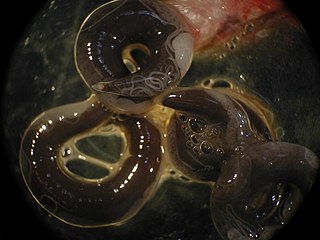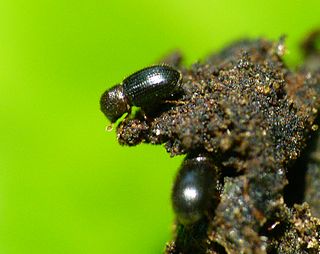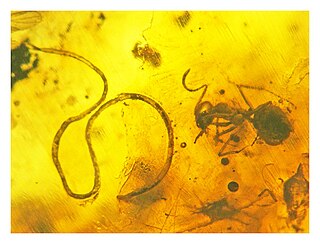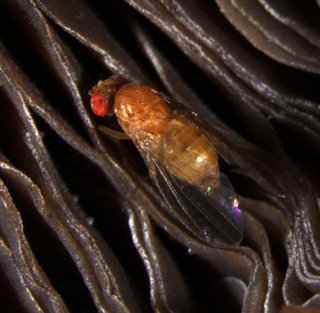
Nematomorpha are a phylum of parasitoid animals superficially similar to nematode worms in morphology, hence the name. Most species range in size from 50 to 100 millimetres, reaching 2 metres (79 in) in extreme cases, and 1 to 3 millimetres in diameter. Horsehair worms can be discovered in damp areas, such as watering troughs, swimming pools, streams, puddles, and cisterns. The adult worms are free-living, but the larvae are parasitic on arthropods, such as beetles, cockroaches, mantises, orthopterans, and crustaceans. About 351 freshwater species are known and a conservative estimate suggests that there may be about 2000 freshwater species worldwide. The name "Gordian" stems from the legendary Gordian knot. This relates to the fact that nematomorphs often coil themselves in tight balls that resemble knots.

Ascaris is a nematode genus of parasitic worms known as the "small intestinal roundworms", which is a type of parasitic worm. One species, Ascaris lumbricoides, affects humans and causes the disease ascariasis. Another species, Ascaris suum, typically infects pigs. Other ascarid genera infect other animals, such as Parascaris equorum, the equine roundworm, and Toxocara and Toxascaris, which infect dogs and cats.
Acanthocheilonema is a genus within the family Onchocercidae which comprises mainly tropical parasitic worms. Cobbold created the genus Acanthocheilonema with only one species, Acanthocheilonema dracunculoides, which was collected from aardwolf in the region of South Africa in the nineteenth century. These parasites have a wide range of mammalian species as hosts, including members of Carnivora, Macroscelidea, Rodentia, Pholidota, Edentata, and Marsupialia. Many species among several genera of filarioids exhibit a high degree of endemicity in studies done on mammalian species in Japan. However, no concrete evidence has confirmed any endemic species in the genus Acanthocheilonema.

Anguillicoloides crassus is a parasitic nematode worm that lives in the swimbladders of eels and appears to spread easily among eel populations after introduction to a body of water. It is considered to be one of the threats to the sustainability of populations of European eel. It was introduced to the European continent in the 1980s, where it was reported independently from Germany and Italy in 1982, having probably been introduced from Taiwan. It is thought to have reached England in 1987 from continental Europe. It is a natural parasite of the Japanese eel in its native range.

Hypothenemus hampei, the coffee berry borer, is a small beetle native to Africa. It is the most harmful insect pest of coffee worldwide. Spanish common names of the insect include barrenador del café, gorgojo del café, and broca del café.

Myrmeconema neotropicum is a tetradonematid nematode parasite. It appears to induce fruit mimicry in the tropical ant. Presently the only known host species is Cephalotes atratus, a South American ant with a black abdomen. Upon infection, the gaster, or bulbous hindmost region of the abdomen, resembles one of the many red berries found in tropical forest canopies.

The nematodes, roundworms or eelworms constitute the phylum Nematoda. They are a diverse animal phylum inhabiting a broad range of environments. Most species are free-living, feeding on microorganisms, but many species are parasitic. The parasitic worms (helminths) are the cause of soil-transmitted helminthiases.
Troglostrongylus is a genus of nematodes which are metastrongyloid lung parasites of domestic cats and small wild cats through the Middle East and North America.

Metaparasitylenchus hypothenemi is a free-living nematode parasite that infects coffee berry borers, small beetles that harm coffee crops worldwide. This nematode has been shown to interfere with the parasitic activity of the coffee berry borer by increasing the mortality of its progeny.

Sphaerularia bombi is an entomopathogenic nematode. It is parasite of bumblebees. It infects and sterilizes gynes or potential queens of bumblebees.
Skrjabinoptera phrynosoma is a parasitic worm in the phylum Nematoda, the most diverse of pseudocoelomates. Like many other parasites, the life cycle of S. phrynosoma is complicated and it involves two hosts – a lizard and an ant.

Huffmanela is a genus of parasitic nematodes, belonging to the family Trichosomoididae.

Drosophila falleni is a species of fly found in northeastern North America. A mycophagous insect, it is known to feed on the fruit bodies (mushrooms) of several genera of fungi, including Agaricus, Amanita, Agrocybe, Boletus, Cortinarius, PluteusGrifola, Polyporus, Hypholoma, Russula, Mycena, Stropharia, and Xerula. The fly can be infested by the parasitic nematode Howardula aoronymphium, which enters the fly larvae when it is feeding on mushrooms.

Cucullanus is a genus of parasitic nematodes. The genus includes more than 100 species.

Heydenius is a collective group genus of fossil mermithid nematodes from the Tertiary period that cannot be placed in extant genera.

František Moravec is a Czech parasitologist who specialises on the Nematodes, especially the nematodes parasites of fishes. His research is mainly in the field of taxonomy of the Nematoda.

Howardula aoronymphium is a species of nematode that infects specialist mushroom-feeding fruit flies such as Drosophila falleni and Drosophila neotestacea. Mated female nematodes pierce the fly larva cuticle and take up residence in the hemolymph where they mature alongside the fly. When the adult fly ecloses, the nematode motherworm has reached full size and sheds juvenile nematodes into the hemolymph which are eventually excreted by either the fly anus or ovipositor. Howardula nematodes can severely impact fly egg development, as infection can effectively sterilize some species.

Drosophila neotestacea is a member of the testacea species group of Drosophila. Testacea species are specialist fruit flies that breed on the fruiting bodies of mushrooms. These flies will choose to breed on psychoactive mushrooms such as the Fly Agaric Amanita muscaria. Drosophila neotestacea can be found in temperate regions of North America, ranging from the north eastern United States to western Canada.

Howardula is a genus of nematode that infests the larvae of mushroom-feeding flies, beetles, and other insects. Various Howardula species and strains infest mushroom-feeding Drosophila, including Howardula aoronymphium and Howardula neocosmis. Howardula husseyi can infest the mushroom phorid Megaselia halterata.
















